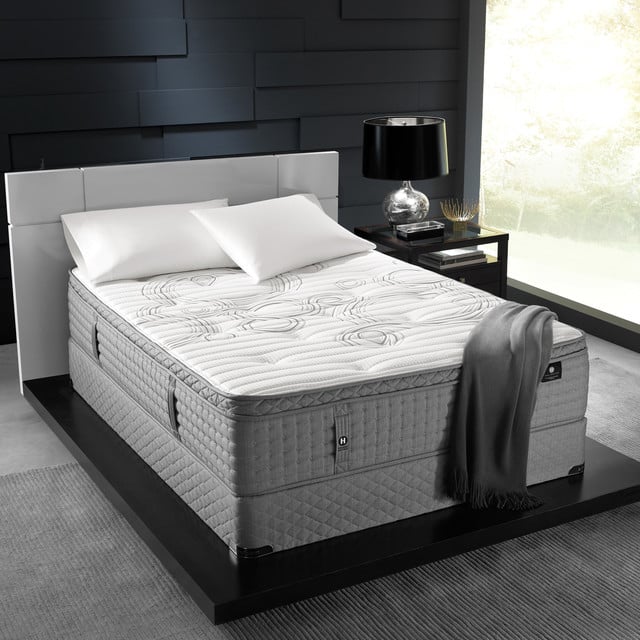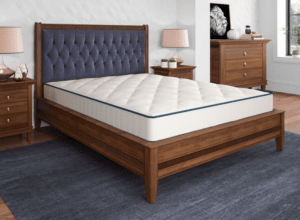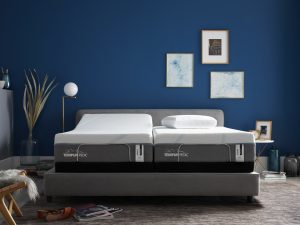
Do Bed Height and Mattress Height Matter?
You may not have given it much thought before. Does bed height and mattress height matter? The answer is yes, and bed height dictates more than just the feel of a room. Having a bed that’s too low or too high can make getting in and out of it somewhat of a challenge. A bed that’s too low will cause you to feel as though you are sleeping on the floor and can make getting into and out of it difficult, especially for those with knee pain. A bed that’s too high can leave shorter sleepers standing on their toes or feeling as though they need a running start to get into it, not to mention the potential for injury for those at risk of tumbling out of bed. Many people who have high beds have to use bed stairs. Little dogs and children may also need bed stairs to get on and off of them.
 The standard bed height is between 18 and 25 inches. Antique beds are usually around 36 inches. This number applies to all bed sizes from twin to California king, corresponding closely with the average knee height of an adult. Platform beds are typically lower than a bed that sits on a box frame or on top of a bedframe. The science behind mattresses has changed a lot in recent decades and though they are about the same thickness, many advancements in technology have resulted in materials that provide equal or better cushioning with less thickness and weight. The average mattress thickness is between eight and 14 inches, and depending on the size and materials used, it can weigh as little as 50 pounds or be as heavy as 150 pounds.
The standard bed height is between 18 and 25 inches. Antique beds are usually around 36 inches. This number applies to all bed sizes from twin to California king, corresponding closely with the average knee height of an adult. Platform beds are typically lower than a bed that sits on a box frame or on top of a bedframe. The science behind mattresses has changed a lot in recent decades and though they are about the same thickness, many advancements in technology have resulted in materials that provide equal or better cushioning with less thickness and weight. The average mattress thickness is between eight and 14 inches, and depending on the size and materials used, it can weigh as little as 50 pounds or be as heavy as 150 pounds.
 Window and door placement can influence your options here. There may be limited space for a bed, and a large bed that is high can be difficult to navigate around the room’s window placements. Many people choose their bed frame primarily to coordinate with their particular design tastes. You don’t often see high beds in contemporary or modern decor, and likewise don’t see many low-to-the-ground platform beds in a more traditionally decorated bedroom filled with antique furniture. If you like to style your bed with many decorative pillows, they may be featured better on a taller bed with a substantial headboard. If you’re a two-pillow minimalist, you might be after a low-profile bed frame that conveys your minimalist style.
Window and door placement can influence your options here. There may be limited space for a bed, and a large bed that is high can be difficult to navigate around the room’s window placements. Many people choose their bed frame primarily to coordinate with their particular design tastes. You don’t often see high beds in contemporary or modern decor, and likewise don’t see many low-to-the-ground platform beds in a more traditionally decorated bedroom filled with antique furniture. If you like to style your bed with many decorative pillows, they may be featured better on a taller bed with a substantial headboard. If you’re a two-pillow minimalist, you might be after a low-profile bed frame that conveys your minimalist style.
 It is recommended that toddlers and other young children who may be more vulnerable to falling out of bed have a bed that is lower to the ground, such as one that’s around eight to 10 inches high. There are many people who skip the crib altogether and begin putting their child to bed immediately on a bed that’s on the floor. Older people may also have specific needs for their bed height, and if falling out of bed becomes a concern or getting in and out of bed is more difficult, then it might be time to reevaluate the bed height.
It is recommended that toddlers and other young children who may be more vulnerable to falling out of bed have a bed that is lower to the ground, such as one that’s around eight to 10 inches high. There are many people who skip the crib altogether and begin putting their child to bed immediately on a bed that’s on the floor. Older people may also have specific needs for their bed height, and if falling out of bed becomes a concern or getting in and out of bed is more difficult, then it might be time to reevaluate the bed height.
 If you’re wondering, don’t adjustable bed frames go up and down? You’re not alone. Adjustable bases have been steadily becoming more popular as people recognize the health benefits and conveniences that they provide. Most adjustable bases raise on either side, underneath the feet and the head, and remain the same height in the middle. Adjustable bed frames like those used in a hospital setting raise and lower completely off of the ground to help medical professionals tend to you with ease and also to aid with any mobility issues that patients may have during their recovery. A large percentage of people buying mattresses these days are looking at adjustable bases in a new and more positive light and find that their convenience is a major life hack.
If you’re wondering, don’t adjustable bed frames go up and down? You’re not alone. Adjustable bases have been steadily becoming more popular as people recognize the health benefits and conveniences that they provide. Most adjustable bases raise on either side, underneath the feet and the head, and remain the same height in the middle. Adjustable bed frames like those used in a hospital setting raise and lower completely off of the ground to help medical professionals tend to you with ease and also to aid with any mobility issues that patients may have during their recovery. A large percentage of people buying mattresses these days are looking at adjustable bases in a new and more positive light and find that their convenience is a major life hack.
Average Height Of Bed
 The standard bed height is between 18 and 25 inches. Antique beds are usually around 36 inches. This number applies to all bed sizes from twin to California king, corresponding closely with the average knee height of an adult. Platform beds are typically lower than a bed that sits on a box frame or on top of a bedframe. The science behind mattresses has changed a lot in recent decades and though they are about the same thickness, many advancements in technology have resulted in materials that provide equal or better cushioning with less thickness and weight. The average mattress thickness is between eight and 14 inches, and depending on the size and materials used, it can weigh as little as 50 pounds or be as heavy as 150 pounds.
The standard bed height is between 18 and 25 inches. Antique beds are usually around 36 inches. This number applies to all bed sizes from twin to California king, corresponding closely with the average knee height of an adult. Platform beds are typically lower than a bed that sits on a box frame or on top of a bedframe. The science behind mattresses has changed a lot in recent decades and though they are about the same thickness, many advancements in technology have resulted in materials that provide equal or better cushioning with less thickness and weight. The average mattress thickness is between eight and 14 inches, and depending on the size and materials used, it can weigh as little as 50 pounds or be as heavy as 150 pounds.
How High Should A Bed Be?
Standard bed height might not be the ideal bed height for you. The perfect height for a bed will vary from person to person and a number of factors can influence this choice. Most experts agree that your knees should make a 90-degree angle to the floor when you are sitting on your bed for the greatest ease of use. Taller beds, such as many canopy beds, can be more difficult for a petite person or youth to get into. They may benefit from having a bed step next to the bed. Beds that are very low can be difficult for people with injuries or mobility issues to get out of or lower themselves onto. Still, a large part of deciding how high a bed should be remains purely up to personal preference. Some people like the feeling of sleeping with a higher vantage point, whereas others love to flop onto a bed that’s near the floor.Generally speaking, it’s easier to raise an existing bed frame than it is to lower it. If you want to know how to make your bed taller, you have some options.A thicker mattress will raise your sleeping surface up higher, and you can look at bed risers for metal frames or other designs that sit on four legs to give you more room underneath. Lowering a bed will require either modifying or replacing your existing bed frame. A crude fix can be had by sawing parts of the legs off of your bed frame, but it would be better to either get a new bed frame or opt for a low-profile base or a thinner mattress.
Room Design and Size
 Window and door placement can influence your options here. There may be limited space for a bed, and a large bed that is high can be difficult to navigate around the room’s window placements. Many people choose their bed frame primarily to coordinate with their particular design tastes. You don’t often see high beds in contemporary or modern decor, and likewise don’t see many low-to-the-ground platform beds in a more traditionally decorated bedroom filled with antique furniture. If you like to style your bed with many decorative pillows, they may be featured better on a taller bed with a substantial headboard. If you’re a two-pillow minimalist, you might be after a low-profile bed frame that conveys your minimalist style.
Window and door placement can influence your options here. There may be limited space for a bed, and a large bed that is high can be difficult to navigate around the room’s window placements. Many people choose their bed frame primarily to coordinate with their particular design tastes. You don’t often see high beds in contemporary or modern decor, and likewise don’t see many low-to-the-ground platform beds in a more traditionally decorated bedroom filled with antique furniture. If you like to style your bed with many decorative pillows, they may be featured better on a taller bed with a substantial headboard. If you’re a two-pillow minimalist, you might be after a low-profile bed frame that conveys your minimalist style.
Room Size
A taller bed may make a smaller room feel cramped, especially if there is other furniture that needs to be included, such as a large chest of drawers. On the contrary, a low-profile bed that’s 16 or so inches off the ground may look a bit lost or uninviting in a room that has generous square footage and not a lot of other furniture. Additionally, your storage needs are something to consider. Feeling starved of storage space may be the reason you find yourself wondering how to make bed taller, as most beds consume prime real estate in a small bedroom or a house where a logical amount of closet space seems to be something the builder forgot to include.Size of Sleeper
The size of the person who most frequently uses the bed will also influence the height. Achieving comfort is the number one priority when selecting your mattress/foundation system, followed closely by quality, price and personal preferences in material. A petite person may feel they have to jump up on a bed that‘s too high, whereas for a tall person, that same bed may feel just right. For beds that see a variety of different sleepers, such as those in a guest room, staying between 18 and 25 inches in height should accommodate the majority of your guests comfortably. People who are of sturdier build are recommended to seek out mattresses that are on the thicker side of the range, as this will aid in maintaining spinal alignment and mattress longevity. Keep this in mind when selecting the right foundation for your mattress.Age of Sleeper
 It is recommended that toddlers and other young children who may be more vulnerable to falling out of bed have a bed that is lower to the ground, such as one that’s around eight to 10 inches high. There are many people who skip the crib altogether and begin putting their child to bed immediately on a bed that’s on the floor. Older people may also have specific needs for their bed height, and if falling out of bed becomes a concern or getting in and out of bed is more difficult, then it might be time to reevaluate the bed height.
It is recommended that toddlers and other young children who may be more vulnerable to falling out of bed have a bed that is lower to the ground, such as one that’s around eight to 10 inches high. There are many people who skip the crib altogether and begin putting their child to bed immediately on a bed that’s on the floor. Older people may also have specific needs for their bed height, and if falling out of bed becomes a concern or getting in and out of bed is more difficult, then it might be time to reevaluate the bed height.
Injury Or Other Physical Limitations To Consider
Imagine having to sleep with your leg in a cast, and you’re trying to get out of a bed that’s nearly to the floor. It’ll definitely be more difficult to stand up than if you were simply able to swing your legs around and, with your good knee already at a 90-degree angle from the ground, rise to standing position. Additionally, if you have a bed that is so high your feet don’t come near the ground, you will have to drop yourself down and climb up into it every time you want to rest. Unforeseen events such as injuries or recovery needs can make a choice you made about the height of your bed when you were feeling sprightly and pain-free feel like a mistake in hindsight. [cta id="shop"]How To Raise A Bed
Raising your bed can be accomplished a few different ways, depending on your motives for the growth spurt. If you simply want a taller bed for personal comfort or feel like you’re sinking into a tar pit in your current bed, look at getting a thicker mattress like the Tempur-Pedic Luxe Breeze and/or pairing it with an adjustable base like the Tempur-pedic Ergo Pro Smart Base. If you are in dire need of additional storage space to provide shelter to your ugly Christmas sweaters or vintage bowling ball collections, then you’re likely looking to gain an additional six inches or so of undercarriage area. Bed risers will raise the height of the bed to something more user-friendly for that storage. If you want a loft-style bed that’s high enough to have livable space underneath, then no bed riser in the world will get you there, and for your safety, we cannot recommend stacking them like Jenga tiles. To achieve this goal, you must enter the territory of the loft bed frame, which is a sturdy bed on stilts or like a bunk bed without the bottom bunk. They are a popular choice for the smaller rooms of city dwellers, kids and college students. Many people put desks or shelving underneath, but there is nothing to stop you from displaying the antique loom you inherited from Uncle Waldo there. Each of these adjustments are rather simple to enact, though the simplest of which is using bed risers underneath the feet of your existing bed frame.Adjustable Bed Frames
 If you’re wondering, don’t adjustable bed frames go up and down? You’re not alone. Adjustable bases have been steadily becoming more popular as people recognize the health benefits and conveniences that they provide. Most adjustable bases raise on either side, underneath the feet and the head, and remain the same height in the middle. Adjustable bed frames like those used in a hospital setting raise and lower completely off of the ground to help medical professionals tend to you with ease and also to aid with any mobility issues that patients may have during their recovery. A large percentage of people buying mattresses these days are looking at adjustable bases in a new and more positive light and find that their convenience is a major life hack.
If you’re wondering, don’t adjustable bed frames go up and down? You’re not alone. Adjustable bases have been steadily becoming more popular as people recognize the health benefits and conveniences that they provide. Most adjustable bases raise on either side, underneath the feet and the head, and remain the same height in the middle. Adjustable bed frames like those used in a hospital setting raise and lower completely off of the ground to help medical professionals tend to you with ease and also to aid with any mobility issues that patients may have during their recovery. A large percentage of people buying mattresses these days are looking at adjustable bases in a new and more positive light and find that their convenience is a major life hack.
